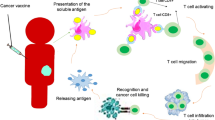Abstract
Cancer cells escape innate and adaptive immune responses by selection of non-immunogenic tumor cell variants (immunoediting) or by active suppression of the immune response (immunosubversion). One common strategy that employs tumor cells to elude a T-cell-mediated immune response is the downregulation or loss of expression of HLA class I molecules, often associated with an induction of the surface expression of HLA class II antigen, nonclassical HLA class I molecules, and/or NK cell-activating ligands such as MICA, MICB, or ULBP. These changes in the surface characteristics of tumor cells result from the selection pressure exerted by immune cells from the innate and adaptive compartment. The tumor antigen characteristics are “immunoedited” in the course of the disease, resulting in the survival of tumor variants with defective antigen presentation, mostly at the level of HLA class I.
Similar content being viewed by others
Author information
Authors and Affiliations
Corresponding author
Additional information
This article is published as part of the Special Issue on Prognostic Impact of Anti-Cancer Immune Responses [33:5].
Rights and permissions
About this article
Cite this article
Pagés, F., Kroemer, G. Prognostic impact of anticancer immune responses: an introduction. Semin Immunopathol 33, 317–319 (2011). https://doi.org/10.1007/s00281-011-0278-4
Received:
Accepted:
Published:
Issue Date:
DOI: https://doi.org/10.1007/s00281-011-0278-4




